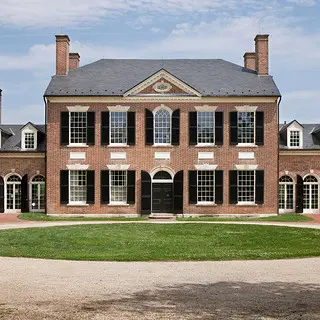
Visit Woodlawn
Plan Your VisitReviews
Woodlawn is a 126-acre estate that was originally part of George Washington’s Mount Vernon. The main Federal-style house was designed by the architect of the U.S. Capitol, Dr. William Thornton, and constructed between 1800 and 1805 as the plantation house for Washington’s nephew, Major Lawrence Lewis, and his wife, Eleanor “Nelly” Custis Lewis.
During the Lewises’ years in residence, Woodlawn plantation comprised over 2,000 acres and was supported by scores of workers, at least 90 of whom were enslaved people of African descent. Many of those slaves were gifted by Nelly’s grandmother, Martha Washington, and other relatives.
In 1846, the Lewises’ son sold the property to Quaker families who made Woodlawn a “free labor colony,” selling lots to free Black and immigrant farmers—a tremendously controversial social experiment nearly two decades before the Emancipation Proclamation.

photo by: Gordon Beall
By the turn of the 20th century, Woodlawn deteriorated and was only saved through the efforts of Elizabeth Sharpe, a Pennsylvania coal heiress. In 1952, Woodlawn became the first historic site owned by the National Trust. Frank Lloyd Wright’s Pope-Leighey House, a ground-breaking Usonian House scheduled for demolition due to widening of Interstate 66, was donated to the National Trust in 1964 and relocated to the grounds of Woodlawn.
Woodlawn actively engages with local descendant communities through programming and research—welcoming visitors from all over the world. The site hosts a wide array of exhibitions, events, and provides tours of both houses between April and December.
Today, the Arcadia Center for Sustainable Food & Agriculture—a nonprofit organization dedicated to creating a more equitable and sustainable local food system in the Washington, D.C area—is based on the historic grounds of Woodlawn's estate. Woodlawn hosts a wide array of events and provides private tours between April and December.

photo by: Gordon Beall
Woodlawn became the first Historic Site of the National Trust for Historic Preservation in 1952.

photo by: Gordon Beall
The National Trust is working with Arcadia Center for Sustainable Food and Agriculture to expand the mission of historic Woodlawn Plantation.

photo by: Gordon Beall
Woodlawn was originally part of the estate at President George Washington's Mount Vernon.
Benefits for National Trust Members
One free single house or combo tour admission
Join the National Trust to enjoy a host of membership benefits.
Join TodayStay connected with us via email. Sign up today.
Related Stories
-
Preservation Magazine Staying Connected, 19th Century Style -
Historic Sites 16 One-of-a-Kind Gifts to Impress
Explore More Places
Now is the time for preservation advocates to engage directly with your members of Congress and elevate the importance of historic preservation in your communities.
Get Started




